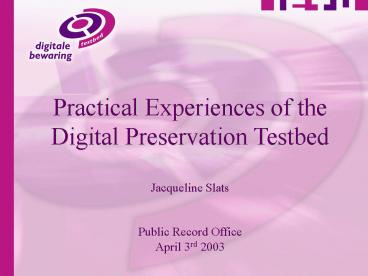Practical Experiences of the - PowerPoint PPT Presentation
1 / 27
Title:
Practical Experiences of the
Description:
Step 3: Authenticity requirements and evaluation checklist. Step ... Met authenticity requirements after manual intervention; not a format for digital longevity ... – PowerPoint PPT presentation
Number of Views:46
Avg rating:3.0/5.0
Title: Practical Experiences of the
1
Practical Experiences of the Digital Preservation
Testbed Jacqueline Slats Public Record
Office April 3rd 2003
2
- Objective of Digital Longevity
- Securing the accessibility of reliable
governmentinformation in the digital era.
3
- Objective of Digital Preservation Testbed
- Securing the sustained accessibility of reliable
government information in the digital era.
4
- Target group
- The government
5
- Coming about of the program Digital Preservation
Testbed - Increasingly, the government is working with
digital documents - and other records
- Dutch Cabinet objective 65 of all transactions
between government and citizens must take place
using digital meansby 2006 - Continuity of the working processes will be
maintained in the digital environmentas well.
6
- Coming about of the Testbed program (cont.)
- Digital information must be accessible, reliable
and interpretable - Strategies, methods and techniques are required
to achieve this.
7
The problem of preservation Technological pace
of change and obsolescence there is no guarantee
that current computer environments and records
can be read in future.
8
- Digital Preservation Testbed is performing
experiments on three strategies for preserving
records without affecting the authenticity of the
records - - Migration
- - Emulation (Universal Virtual Computer)
- - XML
- Is assessing their practical use for theDutch
situation.
9
- Experiments are taking place on
- text documents
- spreadsheets
- electronic mail
- simple databases.
10
Data Preservation is the first and simplest mode
of operation of the UVC approach
11
Research Questions
- Advantages of each preservation approach?
- Factors affecting each approach?
- Effectiveness of each approach?
- Basic Requirements for Preservation
- Which metadata are essential for preservation?
12
Experiment Process (1)
- Step 1 Definition of the process
- Step 2 Preparation for the process
- Step 3 Authenticity requirements and evaluation
checklist - Step 4 Design of the experiments
- Step 5 Resource specification
- Step 6 Go/no go decision
13
Experiment Process (2)
- Step 7 Development of the experiment
- Step 8 Test experiment
- Step 9 Go/no go decision
- Step 10 Run experiment
- Step 11 Evaluate experiment
- Step 12 Consider results
14
Testbed Team
15
- Migration
- the conversion of records from one hardware
and/or software environment to another - currently the most common preservation strategy
for digitalrecords.
16
The UVC emulation approach defined by IBM
Research develops a flexible emulator used to
interpret both data format semantics and emulate
hardware platforms
- The advantages of the IBM Research UVC approach1
- The existence of the UVC drastically simplifies
the emulation problem - For data preservation, it eliminates the need for
agreeing on standardised formats. - Only the UVC interpreter will have to be written
when a new architecture emerges. There is no
impact on the archived information - The UVC is made so general, and at the same time
so basic, that its definition will remain
relevant in the future
- Basic architecture
- Basic instruction set
Universal Virtual Computer (UVC)
1) Long-Term Archiving of Digital Information,
Raymond Lorie, IBM Almaden Research Center, RJ
10185 (95059), March 28, 2000
17
XML (eXtensible Markup Language) XML is
independent of the hard- and software used, and
is thereforeideal for information exchange for
future as well as presentconfigurations.
18
(No Transcript)
19
Text documents (1)
- Results
Process 1(C)
- For active records needs to be repeated every
few years manual checking can only be done if
migration is automated
- Migration from an older version of an application
to a newer version of this application
- Migration from an application to a standard
format PDF and RTF
- PDF is able to preserve text records RTF failed
to represent the original record
- Migration of old records created in one word
processor to another (WP to Word)
- Met authenticity requirements after manual
intervention not a format for digital longevity
20
Text documents (2)
- Results
- Did not meet our authenticity requirements
unsuitable for preservation
- Process 4 (C)
- Viewers
- Process 7 (A)
- Conversion to XML
- Results
- First results with Open Office look promising,
21
- Results
- Met authenticity requirements binary attachments
encoded (Base64)
- Process 2 (C)
- Conversion XML (wrapper approach)
- Process 3 (C)
- Conversion to XML (backbone approach)
- Results
- Met authenticity requirements attachments in
their original file format
22
Spreadsheets
Experiment process
Results
- Emulation UVC data preservation approach
- Generating the logical data description is very
difficult
- For active records needs to be repeated every
few years manual checking can only be done if
migration is automated
- Migration from an older version of an application
to a newer version of this application
- Promising approach, but XML produced by Open
Office and Excel XML not meaningful enough
- Conversion to XML
23
Databases
Experiment process
Results
- Content and structure can be preserved
- Conversion to XML
- Migration of large databases
- No results available yet
- No results available yet
- Migration of small databases
24
- What will the Testbed project provide
- advice on how to deal with current digital
records - recommendations for an appropriate preservation
strategy or a combination of strategies - functional requirements for a preservation
function - cost models of the various preservation
strategies - decision model for preservation strategies
- recommendations concerning guidelines and
regulations.
25
For further information about the
Testbed Website www.digitaleduurzaamheid.nl
e-mail testbed_at_ictu.nl
26
Demonstration
27
Practical Experiences of the Digital Preservation
Testbed Jacqueline Slats Public Record
Office April 3rd 2003































